Chicken Respiratory System
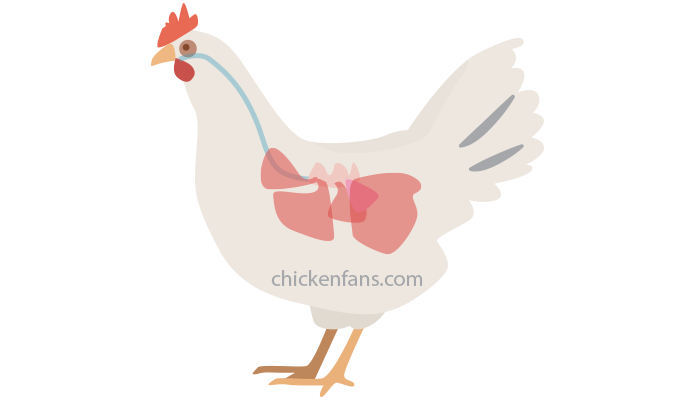
Chickens have an ingenious respiratory system that is quite different from ours. Unfortunately, there are many respiratory diseases affecting backyard chickens.
It can come in handy to understand how a chicken breathes, how the lungs and air sacs work, and why your chicken is panting when it’s hot.
We’ll cover everything there is to know:
- Overview of the Chicken Respiratory System
- Functions of the Respiratory System of a Chicken
- Chicken Lungs
- Chicken Air Sacs
- Respiration in Chickens
- Chicken vs. Human Respiratory System
- Thermoregulation in Chickens
- Impact of Chicken Respiration on Eggshell Formation
- Diseases of the Chicken Respiratory System
- Chicken Respiratory Defense System
- Challenges to the Chicken Respiratory System
- Summary
Overview of the Chicken Respiratory System
Chickens breathe through their mouth and nares. The air travels via the windpipe to a pair of lungs, where the chicken absorbs oxygen, just like humans. From there, it travels through air sacs, which look like tiny balloons. These air sacs help to power activity and flight.
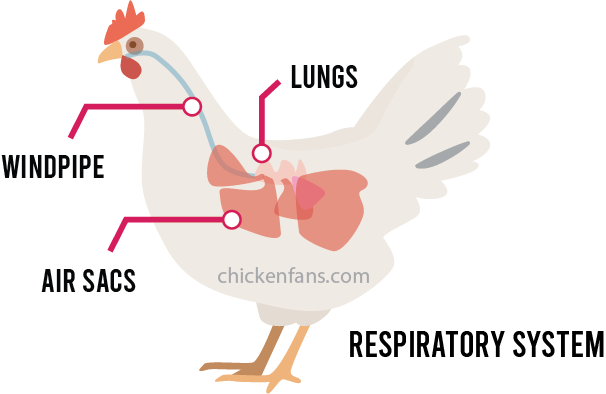
The air goes back and forth between the lungs and air sacs. It takes multiple inhalations and exhalations for the air to pass through all the air sacs and lungs. In the final exhalation, the CO2-rich air from the anterior air sacs is expelled back through the mouth.
Functions of the Respiratory System of a Chicken
The chicken respiratory system has multiple functions:
- Absorption of oxygen (O) and release of carbon dioxide (CO2)
- Temperature regulation and heat release
- Quick adjustments to chemical imbalances
- Vocalization and crowing
As chickens are packed with feathers, they rely on their respiratory system for a stable body temperature. When it’s hot, chickens breathe faster to get rid of heat. Sometimes this can turn into panting and heavy breathing to cool down.
Chicken Lungs
Chickens have 2 lungs. The windpipe of a chicken splits into the left and right bronchi that lead to both lungs. Both bronchi split into smaller secondary and tertiary bronchi. They form a network of tiny corridors that are all connected. These little pipes reach a cellular level, facilitating oxygen absorption and creating a bridge to the air sacs.
The lungs in chickens are small compared to other animals of similar size. One-third of the lung is sitting between the ribs, so they don’t have the same round form as our lungs. They also can’t expand like our lungs do.
Chicken Air Sacs
An adult chicken has eight air sacs, tiny air-filled balloons connected to the lungs via bronchi. Some air sacs connect to hollow pneumatic bones of the skeleton. The hollow bones lighten the bird and help it to fly.
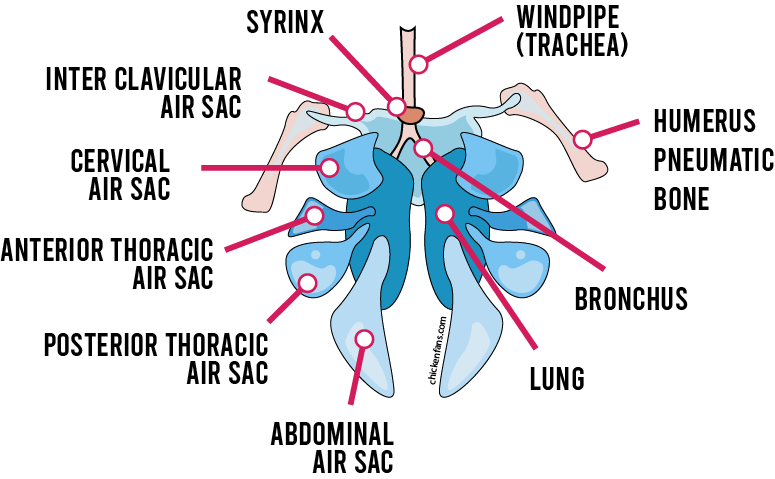
Nine air sacs develop in a chicken embryo:
- Single clavicular air sac
- Pair of cervical air sacs
- Pair of cranial thoracic air sacs
- Pair of caudal thoracic air sacs
- Pair of abdominal air sacs
The single clavicular air sac originates from 4 air sacs growing into each other. The pair of cervical air sacs generally join to form a single air sac in adult chickens. So most chickens end up with eight air sacs. The air sacs are not connected with each other, only with the lungs.
The syrinx in the picture above is the voice box of a chicken. The clavicular air sac surrounds the syrinx. Its function is to create sound, both for roosters and hens. When the muscles around the syrinx contract, the air passing through the membranes produces typical chicken sounds.
The function of the air sacs in chickens
The air sacs have multiple functions:
- they lighten the bird by increasing the volume without increasing the body weight
- they pneumatize some bones by filling them with air cells
- they help balance out body parts
- they help with thermoregulation of the body temperature
- they might strengthen the voice of the birds
Air sacs don’t exchange much oxygen and gas, as they don’t have much vascularization, so they only serve as airways. They also don’t fully swell with air.
Respiration in Chickens
Humans inhale and exhale, and it’s as simple as that. Respiration in chickens is a little more complex with their labyrinth of air sacs and bronchi. They need to inhale and exhale twice for the air to pass through the cycle completely.
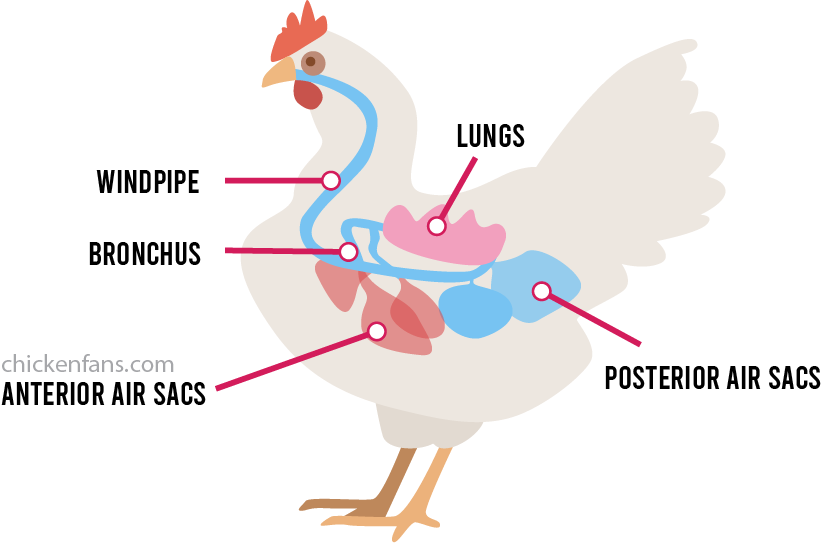
There are four steps in the respiration cycle of a chicken:
- The chicken takes its first breath, and air passes through the windpipe to the posterior air sacs. These are the blue sacs in the picture: the abdominal air sacs and the caudal thoracic air sacs. These air sacs are full of fresh air that’s still high in oxygen.
- The chicken exhales its first breath and pushes the air from the posterior air sacs into the lungs. In the lungs, oxygen (O2) is extracted and exchanged with carbon dioxide (CO2) within a network of tiny capillary blood vessels.
- The second time the chicken inhales, the air moves out of the lungs to the anterior air sacs (red in the picture). These air sacs contain air that’s low in oxygen.
- The second time the chicken exhales, the air from the anterior air sacs is pushed back into the atmosphere through the windpipe.
Respiration is a continuous cycle where these steps overlap. The second time the chicken inhales, new air is also moving into the posterior air sacs while the previous breath is being pushed from the lungs.
This cycle ensures that virtually all oxygen is extracted from the air chickens breathe.
Chicken vs. Human Respiratory System
Humans have a diaphragm that separates our chest and abdomen. This diaphragm contracts to pull air into the lungs. Chickens don’t have a diaphragm, and their lungs can’t contract. They breathe by moving their entire ribcage to draw air into the lungs. That’s why you can accidentally stop a chick from breathing if you hold it with a firm grip.
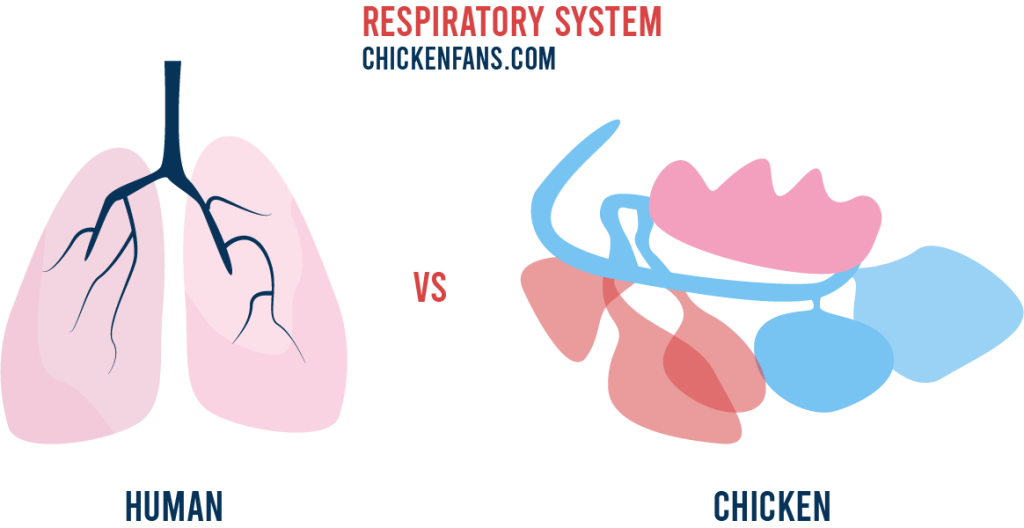
Chickens also have air sacs and a double respiration cycle. While we inhale and exhale the same air, the air in chickens is passing two breaths. This gives the chickens an efficient respiratory system that can extract much more oxygen from the air. When we exhale, there is residual oxygen in the air we breathe. Chickens can extract almost all of the oxygen.
Chickens, however, have no form of skin breathing or cutaneous respirations. We can breathe through our skin, though it only counts for one or two percent of the air we breathe. While the chicken embryo can breathe through the eggshell, chickens carry out little to no gas exchanges across their feather-packed skin.
Thermoregulation in Chickens
Chickens are homeothermic animals that need to keep their body temperature stable between 105°F and 107°F (41°C to 41.7°C). Most chickens are very cold-hardy. Their feathers and metabolism keep them warm when it’s cold outside. Their metabolism kicks into gear to keep the body warm when temperatures drop.
However, when it gets hot outside, it’s a different story. Chickens are packed with feathers and can’t sweat as they have no sweat glands. Chickens can only release heat through the comb, legs, non-feathered body parts, and breathing. They lose heat through the respiratory tract by panting.
As temperature rises, their respiration rate increases, allowing them to cool down via evaporation of their breath. Panting also involves rapid vibration of the upper throat and thin floor of the mouth, also called gular flutter.
Impact of Chicken Respiration on Eggshell Formation
When chickens are panting and their respiration rate increases to release heat, they excrete much more carbon dioxide (CO2).
In normal circumstances, too much carbon dioxide is toxic. Breathing helps remove carbon dioxide from the chicken’s body. This process avoids respiratory acidosis, a condition that makes the blood acidic and decreases the calcification of the shell.
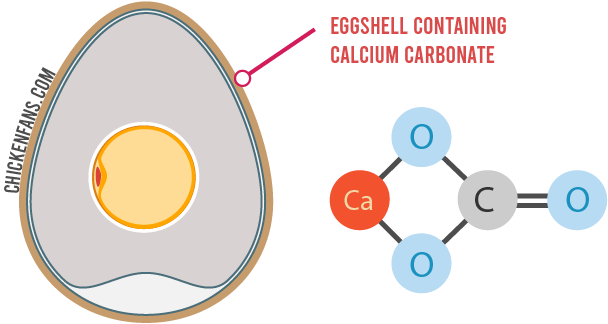
However, minimal carbon dioxide levels are essential to forming a solid eggshell. The eggshell of a chicken consists almost entirely of calcium carbonate (CaCO3), which is made by combining calcium (Ca) with carbon dioxide (CO2). Laying hens often lay thin-shelled or soft shell eggs when it gets hot outside.
That’s why chickens panting to cool down will lay eggs with weaker shells. One way to prevent this is to provide them with extra calcium supplements. An alternative is to give them carbonated drinking water during periods of hot weather. Chickens that drink carbonated water don’t show a drop in eggshell quality as their body has enough carbon available to form calcium carbonate for the eggshell.
Diseases of the Chicken Respiratory System
Respiratory diseases are prevalent in poultry and affect anybody keeping chickens. Most respiratory diseases come with very similar symptoms, such as:
- coughing, sneezing, gurgling sounds, head-shaking
- yawning, open-mouth breathing, gasping for air
- nostrils filled with pus and nasal discharge
- watery, foamy eyes with bubbles
- decreased food intake, loss of appetite
- low egg-production
It can be quite challenging to recognize the correct disease. Only a vet can make an accurate diagnosis.
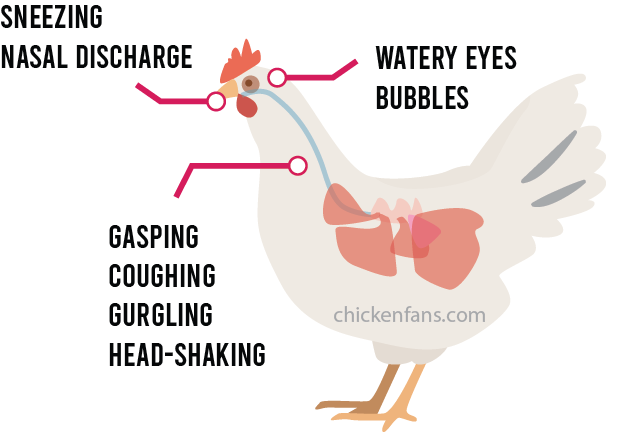
The most common respiratory diseases are:
- Chronic Respiratory Disease – a bacterial infection, also known as mycoplasmosis
- Infectious Coryza – a bacterial infection caused by rod-shaped bacteria
- Infectious Bronchitis – a contagious disease caused by a variety of coronavirus strains
- Infectious Laryngotracheitis – a viral infection caused by the herpes virus
- Fowl Cholera – a bacterial disease that turns chicken combs purple
- Newcastle Disease – a viral infection with the Newcastle Disease virus
Diseases can result in multiple inflammations in the respiratory system. Sinusitis is a general term for any infection that causes inflammation of the sinuses, the cavities in the chicken’s nostrils. When the air sacs of a chicken become inflamed by bacteria or fungi, it’s called airsacculitis.
Chicken Respiratory Defense System
The chicken’s respiratory system has multiple layers of defense to prevent infections and diseases:
- mucociliary clearance or self-cleaning of the respiratory tract
- scavenger cells, white blood cells produced by the immune system
- coughing reflex and sneezing to force mucus and particles out of the respiratory tract
We’re all familiar with coughing and sneezing, so let’s look at the other two ingenious defense mechanisms.
Mucociliary Clearance
The chicken’s airways are self-cleaning, a process which is called mucociliary clearance.
When chickens breathe, they inhale small particles like dust, mold, bacteria, and viruses. The mucus layer in the windpipe and lungs traps most particles preventing them from penetrating the lungs.
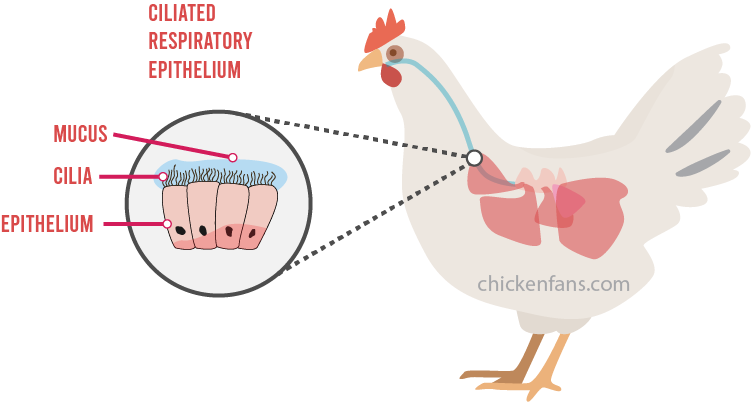
These particles are then removed from the respiratory tract via cilia. These are slender, microscopic hair-like vibrating organelles sitting on the respiratory tract cells. They sweep mucus-containing debris and toxins away from the lungs.
Every cell contains about 200 cilia, and they all beat 1000 times a minute. Together they form beating waves that move the mucus half an inch per minute back to the mouth to be swallowed.
Scavenger Cells
The windpipe or trachea of a chicken splits into multiple bronchi that keep getting smaller and smaller. At the end of the bronchi, there are many tiny air sacs in the lungs, called the alveoli. It’s in these hollow cup-shaped cavities that oxygen is replaced with carbon dioxide.
Since this involves gas exchanges, the alveoli can not be protected by mucus and cilia but have a separate mechanism. The chicken’s immune system produces scavenger cells that hunt down toxic particles, eat them and digest them. These cells are alveolar macrophages, white blood cells that sit on the surface of the alveoli.
The immune system produces extra neutrophils when a chicken gets an infection. Neutrophils are additional white blood cells that help to kill pathogens.
Challenges to the Chicken Respiratory System
A chicken’s respiratory system needs to cope with everything a chicken inhales. This poses regular challenges.
Threats to the respiratory system are:
- dust from bedding, litter, feed, dried droppings and skin, diatomaceous earth, and feathers
- aerosol particles containing viral loads from airborne viruses
- toxins in the air from air pollution and smoke
- ammonia fumes produced by bacteria when they digest chicken droppings
- fungi and molds in the air
When the immune system is busy fighting dust particles, it can be susceptible to infections with viruses and bacteria.
Ammonia Irritation
Gas can be extremely harmful in the chicken coop, as gas particles are much smaller than dust particles. Ammonia fumes are common in hot, moisty weather conditions where ventilation in the coop is insufficient.
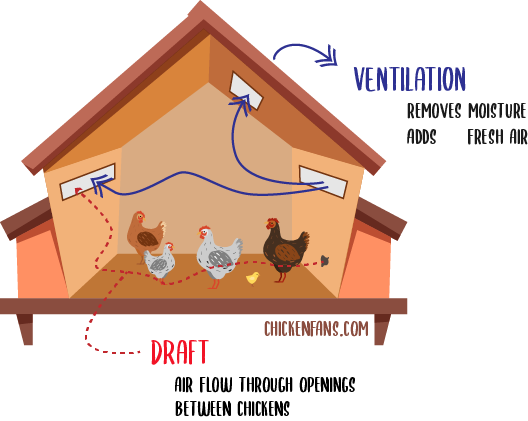
Even small increases in ammonia levels cause:
- disproportionate mucus production in the windpipe
- damage to the cilia in the respiratory tract
- impaired removal of E. coli bacteria from the windpipe, lungs, and air sacs
Proper ventilation removes moisture, carbon dioxide, and ammonia via the roof of the chicken coop. The bottom of the coop should be free from draft.
Summary
A chicken’s respiratory system is an ingenious breathing system that involves many organs. It allows for absorption of oxygen, heat release, vocalization and protects against dust and particles.
Chicken lungs don’t expand as they sit between the ribs. The chicken moves its entire rib cage to breathe. The lungs are connected to eight air sacs that lighten the bird and its bones. A chicken must inhale and exhale twice for the air to completely pass through a respiration cycle. This allows the chicken to extract much more oxygen from the air than humans can.
As chickens have no sweat glands, they pant to release heat. Panting can cause excessive release of carbon dioxide, resulting in weak eggshells.
Many respiratory diseases affect chickens with very similar symptoms. On top of that, a chicken’s respiratory system has a daily challenge of fighting incoming dust particles, aerosols, molds, and gases.
Luckily, a chicken’s respiratory system has many defense systems to prevent diseases. It is self-cleaning, with cilia sweeping away debris in the mucus. The immune system also produces scavenger white blood cells that protect the alveoli.
If you want to read more about chicken health problems, symptoms, and diseases, check out our ‘Health Page‘. You’ll find a ‘Symptom Checker‘, a complete list of ‘Chicken Behavior‘, and an overlook of the most common ‘Chicken Diseases‘. Or go to ‘The Classroom‘ and find a comprehensive list of all Chicken Fans articles.























